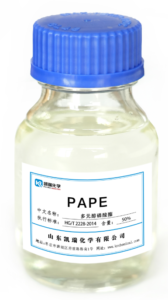The main function of antiscalant PAPE (Phosphonocarboxylic Acid Polymer) is to prevent or inhibit the formation and growth of scale deposits in various industrial processes involving water systems. It is primarily used as a chemical additive in water treatment applications.
Antiscalant PAPE works by sequestering and binding metal ions, such as calcium, magnesium, and iron, which are responsible for the precipitation of scale. By chelating these ions, PAPE prevents their crystallization and deposition, thereby reducing the likelihood of scaling on surfaces such as heat exchangers, pipes, membranes, and other equipment.
Some common applications of antiscalant PAPE include:
- Reverse Osmosis (RO) Systems: PAPE is often added to RO systems to control and inhibit scale formation on the RO membranes. This helps to maintain the efficiency and lifespan of the membranes, ensuring optimal water production and quality.
- Cooling Water Systems: PAPE is utilized in cooling towers and other cooling water systems to prevent scale buildup on heat transfer surfaces. By inhibiting scale formation, it improves heat transfer efficiency and reduces energy consumption.
- Industrial Boilers: PAPE is employed in boiler systems to prevent scale deposition on heat transfer surfaces. By reducing scaling, it enhances heat exchange efficiency, prevents equipment damage, and improves overall system performance.
- Desalination Plants: PAPE is used in desalination plants to mitigate scaling issues on various components, including pumps, valves, and heat exchangers. This helps to maintain the productivity and reliability of the desalination process.
It is important to note that the specific dosage and application of antiscalant PAPE may vary depending on the water composition, operating conditions, and equipment involved. Therefore, it is essential to consult with water treatment experts or manufacturers for proper implementation and dosage recommendations.
